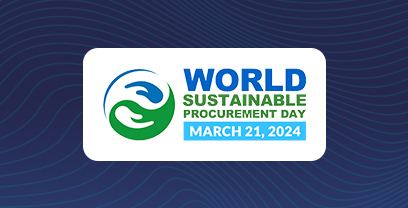|
The Forrester Wave™: Supplier Value Management Platforms, Q3 2024 See Report
Blog »
It’s Time for Procurement to own Scope 3 Emissions

di Vishal Patel
Why should Procurement own Scope 3 Emissions? The answer is simple- suppliers and spend.
For most procurement (and supply chain) professionals, the topic of Scope 1, 2, and 3 emissions should be coming at you from every direction. Most organizations are familiar with Scope 1 and 2, as they are direct and indirect emissions from your own operations. However, Scope 3 is an essential component to tackle – and it’s also one of the most challenging. Scope 3 emissions include the indirect emissions from an organization’s value chain. In the diagram below, it’s clear that the main area of impact for Procurement is upstream Scope 3 emissions.
GHG Emissions: Scope 1 – 3
To further complicate things, Scope 3 emissions for one organization are the Scope 1 and 2 emissions of another organization. Scope 3 emissions are the largest source of greenhouse gas (GHG) emissions for an organization–extracted from a wide range of activities–including purchased goods and services, waste disposal, capital goods, and business travel. According to CDP, Scope 3 emissions represent 75% of an organization’s total emissions. Understanding, managing, and reducing Scope 3 emissions is an essential part of any reduction objective or net-zero goal established by corporate boards and executives.
Why Should Procurement Prioritize Scope 3?
- Significantly impacts and contributes to the fight against climate change
- Customers care and value these initiatives greatly
- This is a top agenda item for CEO’s and boards
- The organization’s reputation and market value is at stake
- Rapidly growing legal and regulatory requirements for reporting and disclosure of Scope 3 emissions
- Parallels between cost reduction and emission reduction–it all starts with data.
Key Steps to Get Started
As Procurement professionals, you play a crucial role in reducing Scope 3 emissions–first by understanding emissions, and then, collaborating with your suppliers. Notwithstanding, there is a lot of groundwork to cover first. Below, we list a few high-level actions to get you started:
- Establish a strategy to generate reliable Scope 3 emission data based on categories and spend. It will require a combination of 3rd party data (from sources such as Exiobase, Ademe, CDP, etc), supplier data and spend data (e.g., POs, and invoices).
- Develop a clear governance structure and process to establish an emission baseline and to adjust and validate scope 3 emission data.
- Begin capturing supplier-level documentation, certificates and additional supplier – provided data (many will not have sufficient information on this)
- Extend your supplier risk management framework to incorporate environmental impact risk
- Establish a mechanism for category managers to put in place Emission Reduction plans based on category and product-level emission data and by collaborating with suppliers.
- Formalize the reporting of Scope 3 emissions, reduction targets, progress, etc.
- Ensure emission data is readily accessible across the source-to-pay process. This will ensure sourcing and purchasing decisions take emissions into account. It will also ensure that supplier profiles are enriched with sustainability data.
This, in my view, is the perfect place to show procurement value and strategy. As the gatekeeper to an organization’s suppliers and the function orchestrating its spend, establishing a strategy to measure and reduce Scope 3 emissions should be a top priority. It’s certainly not an easy task and with all the other things that procurement is asked to focus on (e.g., cost savings, supply continuity, supplier risk, etc.) it may be difficult to prioritize it, but there is no way around it. Every organization will have to report on scope 3 emissions and if not procurement, another function will own this and procurement will likely have to support anyway due to the focus on suppliers and spend.
Procurement Beware
The devil is always in the details. As this is a “hot” space there are lots of technology providers and vendors that are focusing on this. So, as procurement begins to evaluate technologies that can help with this, here are a few things to be wary of:
- Not all of your suppliers will be able to provide you with the Scope 3 data you need, so you’ll need a way to calculate this. Specifically, you will need a baseline model to identify commodities and suppliers that are the top drivers of your Scope 3 emissions and put them on a watchlist to focus data collection, reporting, and action planning initiatives.
- Corporate emission data from suppliers’ CSR reports or 3rd party climate change questionnaires are not actionable. You need emission data that will allow category managers and buyers to report emissions tied to their organization’s purchasing activity at a category or product level.
- Be sure to ask how the technology provider uses “Emission Factors” to calculate Scope 3 emissions and how those may produce category-level or product-level baseline intensities.
- A one-time yearly effort to collect and report on Scope 3 emission data in a stand alone solution is fine but it will be difficult to use on an ongoing basis, to support sourcing initiatives, drive greener purchasing decisions, and develop concrete carbon emission reduction plans.
Many Procurement leaders are already taking bold steps towards sustainability by integrating Scope 3 emissions management into their operations. We’re already seeing new roles within procurement such as “Supplier Carbon Manager” that are being created to help organizations track and reduce these emissions and work with category managers to help develop and execute a strategy.
By joining forces with your suppliers to reduce Scope 3 emissions, you can not only satisfy regulatory requirements–but also demonstrate a commitment to the environment and make real progress. There are many additional benefits: customers become more loyal and employees feel greater satisfaction while the reputation of your organization improves in turn!
Uniting with your suppliers to reduce Scope 3 emissions can reap rewards beyond regulatory compliance. Not only will you support the environment, but also create a more loyal customer and employee base—all while enhancing your company’s reputation!
RESOURCES: EIC Data Sheet, EIC Landing Page

Vishal Patel
VP Product Marketing
Vishal has spent the last 15 years in various roles within the Procurement and Supply Chain technology market. As an industry analyst, he researched and advised organizations in various industries on best and innovative practices, digitization and optimization. He brings a thorough understanding of market trends and digital technologies that can help enterprises be more effective with their Procurement and Supply Chain strategies. He works to ensure that organizations are empowered with technology platforms that enable flexibility, innovation, and agility.
You can connect with Vishal on Linkedin


